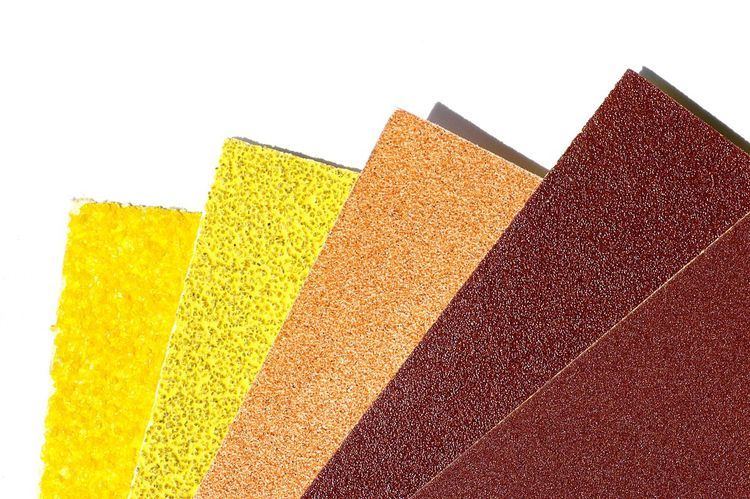 | ||
Sandpaper or glasspaper are names used for a type of coated abrasive that consists of sheets of paper or cloth with abrasive material glued to one face. Despite the use of the names neither sand nor glass are now used in the manufacture of these products as they have been replaced by other abrasives such as aluminium oxide or silicon carbide. Sandpaper is produced in a range of grit sizes and is used to remove material from surfaces, either to make them smoother (for example, in painting and wood finishing), to remove a layer of material (such as old paint), or sometimes to make the surface rougher (for example, as a preparation for gluing). It is common to use the name of the abrasive when describing the paper, e.g. "aluminium oxide paper", or "silicon carbide paper".
Contents
The grit size of sandpaper is usually stated as a number that is inversely related to the particle size. A small number such as 20 or 40 indicates a coarse grit, while a large number such as 1500 indicates a fine grit.
History
The first recorded use of sandpaper was in 1st-century China when crushed shells, seeds, and sand were bonded to parchment using natural gum. Shark skin (placoid scales) has also been used as an abrasive and the rough scales of the living fossil, Coelacanth are used for the same purpose by the natives of Comoros. Boiled and dried, the rough horsetail plant is used in Japan as a traditional polishing material, finer than sandpaper. Glass paper was manufactured in London by 1833 by John Oakey, whose company had developed new adhesive techniques and processes, enabling mass production. Glass frit has sharp-edged particles and cuts well whereas sand grains are smoothed down and do not work well as an abrasive. Cheap sandpaper was often passed off as glass paper; Stalker and Parker cautioned against it in A Treatise of Japaning and Varnishing published in 1688. In 1921, 3M invented a sandpaper with silicon carbide grit and a waterproof adhesive and backing, known as Wet and dry. This allowed use with water, which would serve as a lubricant to carry away particles that would otherwise clog the grit. Its first application was in automotive paint refinishing.
Types
There are many varieties of sandpaper, with variations in the paper or backing, the material used for the grit, grit size, and the bond.
Backing
In addition to paper, backing for sandpaper includes cloth (cotton, polyester, rayon), PET film, and "fibre", or rubber. Cloth backing is used for sandpaper discs and belts, while mylar is used as backing for extremely fine grits. Fibre or vulcanized fibre is a strong backing material consisting of many layers of polymer impregnated paper. The weight of the backing is usually designated by a letter. For paper backings, the weight ratings range from "A" to "F," with A designating the lightest and F the heaviest. Letter nomenclature follows a different system for cloth backings, with the weight of the backing rated J, X, Y, T, and M, from lightest to heaviest. A flexible backing allows sandpaper to follow irregular contours of a workpiece; relatively inflexible backing is optimal for regular rounded or flat surfaces. Sandpaper backings may be glued to the paper or form a separate support structure for moving sandpaper, such as used in sanding belts and discs. Stronger paper or backing increases the ease of sanding wood. The harder the backing material, the faster the sanding, the faster the wear of the paper and the rougher the sanded surface.
Type of abrasive
Types of abrasive materials include:
Sandpaper may be "stearated" where a dry lubricant is loaded to the abrasive. Stearated papers are useful in sanding coats of finish and paint as the stearate "soap" prevents clogging and increases the useful life of the sandpaper.
The harder the grit material, the easier the sanding of surfaces like wood. The grit material for polishing granite slab must be harder than granite.
Bonds
Different adhesives are used to bond the abrasive to the paper. Hide glue is still used, but this glue often cannot withstand the heat generated during machine sanding and is not waterproof. Waterproof or wet/dry sandpapers use a resin bond and a waterproof backing.
Sandpapers can also be open coat, where the particles are separated from each other and the sandpaper is more flexible. This helps prevent clogging of the sandpaper. Wet and dry sandpaper is more effective used wet because clogging is reduced by particles washing away from the grinding surface. Arguably there are also benefits due to lubrication and cooling.
Shapes
Sandpaper comes in a number of different shapes and sizes:
Grit sizes
Grit size refers to the size of the particles of abrading materials embedded in the sandpaper. Several standards have been established for grit size. These standards establish not only the average grit size, but also the allowable variation from the average. The two most common are the United States CAMI (Coated Abrasive Manufacturers Institute, now part of the Unified Abrasives Manufacturer's Association) and the European FEPA (Federation of European Producers of Abrasives) "P" grade. The FEPA system is the same as the ISO 6344 standard. Other systems used in sandpaper include the Japanese Industrial Standards Committee (JIS), the micron grade (generally used for very fine grits). The "ought" system ({0, 00, 000, ...} aka {1/0, 2/0, 3/0, ...}) was used in the past in the US. Cheaper sandpapers sometimes use nomenclature such as "Coarse", "Medium" and "Fine", but it is unclear to what standards these names refer.
Grit size table
The following table, compiled from the references at the bottom, compares the CAMI and "P" designations with the average grit size in micrometres (µm).
